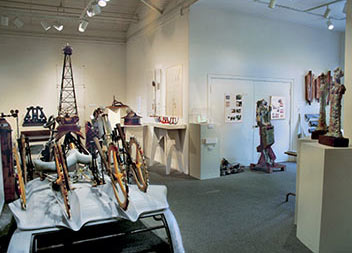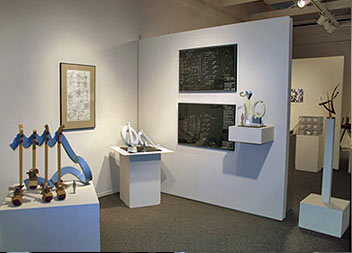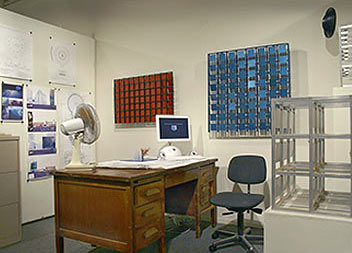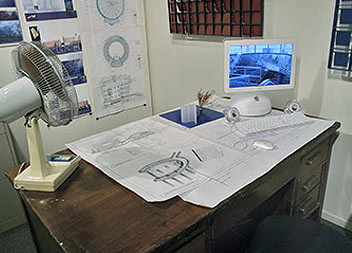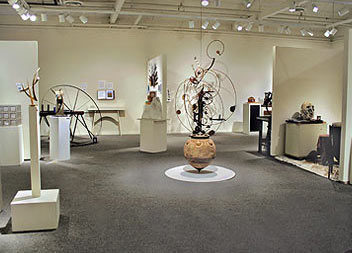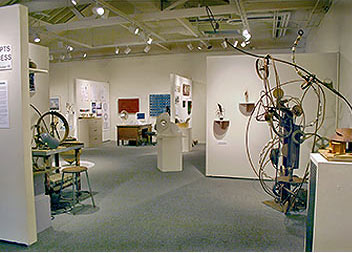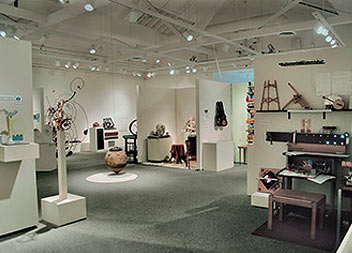August 18 — October 15, 2005
Curator's Statement
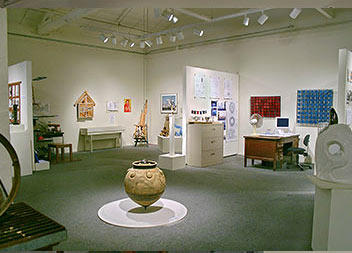
By Michael McGinnis
Concepts and Process is a sculpture exhibit of unusual fashion. Art is most often seen apart from its creator and from the environment that spawned its formation. This reality places the work into a position of magic: "how did they do that," "I can't even imagine where they got their ideas," "I could never do that." Although these thoughts are often justified, it helps to understand the origins, methods, tools, and mindset involved in creating works of art. While mysteries may be revealed, a deeper appreciation of the arts should arise, and who knows, you may discover a kinship with the artistic way of life.
We've brought together 25 artists in a unique and fun way serving the educational needs of our students and community. Presented are scale models, maquettes, drawings, plans, proposals, work in progress, finished examples, process photos, video presentations, and artists' studio vignettes. I have had the privilege of visiting most of the artists in their studios, spread far and wide around Sonoma County, in an effort to gather work. Few of us have had this opportunity. Every artist that I contacted was open to participation, and most allowed me to rummage through their space and take what I wanted. Here are a few observations: they work in constant (controlled) chaos, have lots and lots of material resources, and (on a few occasions) own unbelievable shops the likes of which I have only seen in my dreams. All in all, I found an amazing kinship of my own. My only regret is that I could not get a hold of more of the talented sculptors in our magnificent county. I'm sure they have plenty of new and unique approaches for us to discover
Making sculpture is hard, physically demanding work. Many skills and techniques must be learned before successful results can be achieved. Our students should recognize that they are at the beginning of a long, difficult, wonderful road of learning that will in time allow them to attain the level of mastery demonstrated in these sculptors' work.
Many processes are represented: bronze casting, metal forming, stone carving, wood carving, assemblage, construction, machining techniques, electrical, electronic, mechanistic, and kinetic concepts. This is a daunting, but by no means complete list of options available to sculptors today. Scale is of great importance in this exhibit. Many pieces are the maquettes (3-dimensional sketch) for very large works shown elsewhere in the county and around the country. Sculptors work out ideas with these models, sometimes submitting them to prospective buyers or competitions. Although the small pieces may represent much work in them selves, this cannot compare to the effort involved in producing architecturally scaled pieces in time, difficulty, cost, structural problem solving, and space-consumption. We gotta hand it to those who have no fear of this process.
Drawing is important to all forms of creative endeavor. Its importance should not be underestimated. Often, it is the preferred method of problem solving before and during the creation of complex work. In conjunction with models, drawing is used to make proposals. Good drawing skills can lead to more and higher-value commissions, but its best value is to the artist who relies on drawing to stay loose, document thoughts, and communicate more quickly.
Proposals are also made using digital photography from maquettes to great effect. Computer skills are increasingly valued by artists for communication, documentation, pure artistic creation, and even Computer Aided Design (CAD), which can communicate directly to machinery or manufacturers. As such, not all artists work alone. Those working in large scale often rely on others with expertise in many areas. Artisans and craftspeople are of equal value to the artist. Without them, many pieces would simply be left unmade. Sculptors, with all of their technical challenges, are free to rely on others with skills like or better than their own. Of course, there are exceptions to every rule; some sculptors are masters in nearly every subject and are driven to produce beyond normal capability.
This show was developed as part of SCULPTURE SONOMA 2005, a countywide venture between multiple venues, showcasing our often hidden sculptural talents. Most of the artists in this exhibit are showing finished pieces elsewhere, or in the near future in this gallery. I encourage you to tour the entire range of venues. On hand is a desk copy of the SCULPTURE SONOMA 2005 catalog so that you can find out what is happening at these locations:
Arts Council of Sonoma County
Charles M. Schultz Museum
City of Cloverdale — Cloverdale Plaza
City of Santa Rosa
Museum of Contemporary Art
Paradise Ridge Sculpture Grove
Santa Rosa Junior College — Robert F. Agrella Art Gallery
Santa Rosa Junior College — Mahoney Library
Sebastopol Center for the Arts
Sonoma County Museum
Sonoma Valley Museum of Art
University Art Gallery — Sonoma State University
City of Santa Rosa
Museum of Contemporary Art
Paradise Ridge Sculpture Grove
Santa Rosa Junior College — Robert F. Agrella Art Gallery
Santa Rosa Junior College — Mahoney Library
Sebastopol Center for the Arts
Sonoma County Museum
Sonoma Valley Museum of Art
University Art Gallery — Sonoma State University

